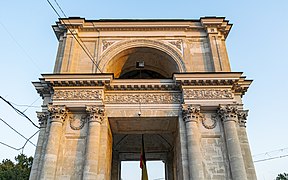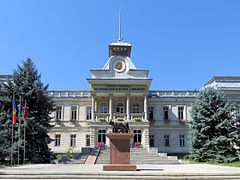Chişinau
Moldova has a history of winemaking dating back to at least 3,000 BCE, and as the capital city, Chișinău hosts the yearly national wine festival every October. Though the city's buildings were badly damaged during the Second World War and earthquakes, there remains a rich architectural heritage, especially in the form of Socialist realism and Brutalist architecture. The city's central railway station boasts a Russian-Imperial architectural style, and maintains direct rail links to Romania. The Swiss-Italian-Russian architect Alexander Bernardazzi designed many of the city's buildings, including the Chișinău City Hall, Church of Saint Theodore, and the Church of Saint Panteleimon. The city hosts the National Museum of Fine Arts, Moldova State University, Brancusi Gallery, the National Museum of History of Moldova with over 236,000 exhibits, and bustling markets in the north of the city, including the house where Alexander Pushkin once resided while in exile from Alexander I of Russia, and which has now been turned into a museum. The city's Nativity Cathedral, located at the centre of the city and constructed in the 1830s, has been described as a "masterpiece" of Neoclassical architecture.
Etymology
The origin of the city's name is unclear. A theory suggests that the name may come from the archaic Romanian word chișla (meaning "spring", "source of water") and nouă ("new"), because it was built around a small spring, at the corner of Pușkin and Albișoara streets.
The other version, formulated by (or attributed to) Ștefan Ciobanu, (occasionally to Iorgu Iordan) Romanian historian and academician, holds that the name was formed the same way as the name of Chișineu (alternative spelt as Chișinău) in Western Romania, near the border with Hungary. Its Hungarian name is Kisjenő, from which the Romanian name originates. Kisjenő comes from kis "small" and the Jenő, one of the seven Hungarian tribes that entered the Carpathian Basin in 896. At least 24 other settlements are named after the Jenő tribe.
A third theory by Kiss Lajos linguist and slavist hold (as possible origin), that the name came from the cuman kešene ("grave", kurgan) and the karachayian "cemetery", and these came from the Persian kāšāne (house) word.[1]
Chișinău is known in Russian as Kishinyov (Кишинёв, pronounced [kʲɪʂɨˈnʲɵf]), while Moldova's Russian-language media call it Kishineu (Кишинэу, pronounced [kʲɪʂɨˈnɛʊ]). It is written Kişinöv in the Latin Gagauz alphabet. It was also written as Chișineu in pre–20th-century Romanian and as Кишинэу in the Moldovan Cyrillic alphabet. Historically, the English-language name for the city, Kishinev, was based on the modified Russian one because it entered the English language via Russian at the time Chișinău was part of the Russian Empire (e.g. Kishinev pogrom). Therefore, it remains a common English name in some historical contexts. Otherwise, the Romanian-based Chișinău has been steadily gaining wider currency, especially in written language. The city is also historically referred to as Lithuanian: Kišiniovas, Hungarian: Kisjenő, German: Kischinau, (German: [ˌkɪʃiˈnaʊ̯] ); Polish: Kiszyniów, (Polish: [kʲiˈʂɨɲuf] ); Ukrainian: Кишинів, romanized: Kyshyniv, (Ukrainian: [ˈkɪʃɪnʲiv] ); Bulgarian: Кишинев, romanized: Kishinev; Yiddish: קעשענעװ, romanized: Keshenev; or Turkish: Kişinev
History
First Bulgarian Empire 681–968
Kievan Rus 969–971
Mongol Empire 1241–1263
Golden Horde 1241–1327
Kingdom of Hungary 1328–1359
Principality of Moldavia 1328–1386, 1436–1812
Grand Duchy of Lithuania 1387–1502
Ottoman Empire 1503–1806
Russian Empire 1812–1917
Russian Republic 1917
Moldavian Democratic Republic 1917–1918
Kingdom of Romania 1918–1940
Soviet Union 1940–1941
Kingdom of Romania 1941–1944
Soviet Union 1944–1991
Moldova 1991–present
Moldavian period
Founded in 1436 as a monastery village, the city was part of the Principality of Moldavia (which, starting with the 16th century became a vassal state of the Ottoman Empire, but still retaining its autonomy). At the beginning of the 19th century Chișinău was a small town of 7,000 inhabitants.
Russian Imperial period

In 1812, in the aftermath of the Russo-Turkish War (1806–1812), the eastern half of Moldavia was ceded by the Ottomans to the Russian Empire. The newly acquired territories became known as Bessarabia.
Under Russian government, Chișinău became the capital of the newly annexed oblast (later guberniya) of Bessarabia. By 1834, an imperial townscape with broad and long roads had emerged as a result of a generous development plan, which divided Chișinău roughly into two areas: the old part of the town, with its irregular building structures, and a newer city centre and station. Between 26 May 1830 and 13 October 1836 the architect Avraam Melnikov established the Catedrala Nașterea Domnului with a magnificent bell tower. In 1840 the building of the Triumphal Arch, planned by the architect Luca Zaushkevich, was completed. Following this the construction of numerous buildings and landmarks began.
On 28 August 1871, Chișinău was linked by rail with Tiraspol, and in 1873 with Cornești. Chișinău-Ungheni-Iași railway was opened on 1 June 1875 in preparation for the Russo-Turkish War (1877–1878). The town played an important part in the war between Russia and the Ottoman Empire, as the main staging area of the Russian invasion. During the Belle Époque, the mayor of the city was Carol Schmidt, whose contribution to the modernisation of the city is still commemorated by Moldovans. Its population had grown to 92,000 by 1862, and to 125,787 by 1900.
Pogroms and pre-revolution
In the late 19th century, especially due to growing anti-Semitic sentiment in the Russian Empire and better economic conditions in Moldova, many Jews chose to settle in Chișinău. By the year 1897, 46% of the population of Chișinău was Jewish, over 50,000 people.
As part of the pogrom wave organized in the Russian Empire, a large anti-Semitic riot was organized in the town on 19–20 April 1903, which would later be known as the Kishinev pogrom. The rioting continued for three days, resulting in 47 Jews dead, 92 severely wounded, and 500 suffering minor injuries. In addition, several hundred houses and many businesses were plundered and destroyed. Some sources say 49 people were killed. The pogroms are largely believed to have been incited by anti-Jewish propaganda in the only official newspaper of the time, Bessarabetz (Бессарабецъ). Mayor Schmidt disapproved of the incident and resigned later in 1903. The reactions to this incident included a petition to Tsar Nicholas II of Russia on behalf of the American people by US President Theodore Roosevelt in July 1903.
On 22 August 1905, another violent event occurred: the police opened fire on an estimated 3,000 demonstrating agricultural workers. Only a few months later, on 19–20 October 1905, a further protest occurred, helping to force the hand of Nicholas II in bringing about the October Manifesto. However, these demonstrations suddenly turned into another anti-Jewish pogrom, resulting in 19 deaths.
Romanian period

Following the Russian October Revolution, Bessarabia declared independence from the crumbling empire, as the Moldavian Democratic Republic, before joining the Kingdom of Romania. As of 1919, Chișinău, with an estimated population of 133,000, became the second largest city in Romania.
Between 1918 and 1940, the center of the city undertook large renovation work. Romania granted important subsidies to its province and initiated large scale investment programs in the infrastructure of the main cities in Bessarabia, expanded the railroad infrastructure and started an extensive program to eradicate illiteracy.
In 1927, the Stephen the Great Monument, by the sculptor Alexandru Plămădeală, was erected. In 1933, the first higher education institution in Bessarabia was established, by transferring the Agricultural Sciences Section of the University of Iași to Chișinău, as the Faculty of Agricultural Sciences.
World War II
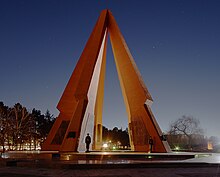
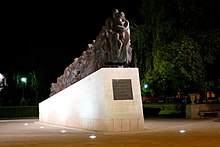


On 28 June 1940, as a direct result of the Molotov–Ribbentrop Pact, Bessarabia was annexed by the Soviet Union from Romania, and Chișinău became the capital of the newly created Moldavian Soviet Socialist Republic.
Following the Soviet occupation, mass deportations, linked with atrocities, were executed by the NKVD between June 1940 and June 1941. More than 400 people were summarily executed in Chișinău in July 1940 and buried in the grounds of the Metropolitan Palace, the Chișinău Theological Institute, and the backyard of the Italian Consulate, where the NKVD had established its headquarters. As part of the policy of political repression of the potential opposition to the Communist power, tens of thousand members of native families were deported from Bessarabia to other regions of the USSR.
A devastating earthquake occurred on 10 November 1940, measuring 7.4 (or 7.7, according to other sources) on the Richter scale. The epicenter of the quake was in the Vrancea Mountains, and it led to substantial destruction: 78 deaths and 2,795 damaged buildings (of which 172 were destroyed).
In June 1941, in order to recover Bessarabia, Romania entered World War II under the command of the German Wehrmacht, declaring war on the Soviet Union. Chișinău was severely affected in the chaos of the Second World War. In June and July 1941, the city came under bombardment by Nazi air raids. However, the Romanian and newly Moldovan sources assign most of the responsibility for the damage to Soviet NKVD destruction battalions, which operated in Chișinău until 17 July 1941, when it was captured by Axis forces.
During the German and Romanian military administration, the city suffered from the Nazi extermination policy of its Jewish inhabitants, who were transported on trucks to the outskirts of the city and then summarily shot in partially dug pits. The number of Jews murdered during the initial occupation of the city is estimated at 10,000 people. During this time, Chișinău, part of Lăpușna County, was the capital of the newly established Bessarabia Governorate of Romania.
As the war drew to a conclusion, the city was once again the scene of heavy fighting as German and Romanian troops retreated. Chișinău was captured by the Red Army on 24 August 1944 as a result of the Second Jassy–Kishinev offensive.
Soviet period
After the war, Bessarabia was fully reintegrated into the Soviet Union, with around 65 percent of its territory as the Moldavian SSR, while the remaining 35 percent was transferred to the Ukrainian SSR.
Two other waves of deportations of Moldova's native population were carried out by the Soviets, the first one immediately after the Soviet reoccupation of Bessarabia until the end of the 1940s and the second one in the mid-1950s.

In the years 1947 to 1949, the architect Alexey Shchusev developed a plan with the aid of a team of architects for the gradual reconstruction of the city.
There was rapid population growth in the 1950s, to which the Soviet administration responded by constructing large-scale housing and palaces in the style of Stalinist architecture. This process continued under Nikita Khrushchev, who called for construction under the slogan "good, cheaper, and built faster." The new architectural style brought about dramatic change and generated the style that dominates today, with large blocks of flats arranged in considerable settlements. These Khrushchev-era buildings are often informally called Khrushchyovka.
The period of the most significant redevelopment of the city began in 1971, when the Council of Ministers of the Soviet Union adopted a decision "On the measures for further development of the city of Kishinev," which secured more than one billion rubles in investment from the state budget, and continued until the independence of Moldova in 1991. The share of dwellings built during the Soviet period (1951–1990) represents 74.3 percent of total households.
On 4 March 1977, the city was again jolted by a devastating earthquake. Several people were killed, and panic broke out. The Intourist Hotel, a flagship property constructed by the Soviet state-owned travel monopoly of the same name, was completed in 1978.
On 22 April 1993, the city inaugurated the Monument to the Victims of Jewish Ghettos, a public monument centring on a bronze statue of the Biblical prophet Moses, which serves as a symbol of remembrance to the thousands of Jews who perished during the holocaust. The monument was designed by architect Simeon Shoihet and sculptor Naum Epelbaum. It stands on Ierusalim Street, marking the site of the main entrance to the Chișinău ghetto, which was established in the lower part of the city in July 1941, shortly after the German and Romanian troops occupied the area.
After independence
Since Moldovan independence following the dissolution of the Soviet Union, many streets of Chișinău have been renamed after historic persons, places or events. Independence from the Soviet Union was followed by a large-scale renaming of streets and localities from a Communist theme into a national one.
On 5 September 2022, the country's first Christian university Universitatea Moldo-Americană opened its doors, supported by the Scandinavian broadcaster Visjon Norge and several donors in Norway, and run in cooperation with the American Southeastern University in Florida, United States.
Following Russia's invasion of Ukraine, Moldova allowed more than 600,000 Ukrainian civilians to flee Ukraine across their border. Despite being among the poorest states in Europe, Moldova has continued to host more than 100,000 Ukrainian refugees, many of them in Chișinău.
On 23 November 2022, the Chișinău Court of Appeal ruled that Chișinău International Airport will return to state ownership, according to justice minister Sergiu Litvinenco, more than three months after an international court allowed Moldova to terminate a 49-year concession deal with airport operator Avia Invest. In April 2023, the Dutch government opened a new embassy in Chișinău.
On 21 May 2023, tens of thousands of Moldovans took to the streets in a massive rally, the European Moldova National Assembly, to support the country's European Union membership bid. Moldovan police said more than 75,000 demonstrators were present at the rally organised by Moldovan president Maia Sandu.
Later that month, Chișinău hosted a major international summit of the European Political Community organised to discuss the illegal Russian invasion of Ukraine as well as cybersecurity, migration and energy security, and regional issues in Azerbaijan, Armenia, and clashes in Kosovo.
Geography
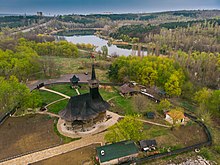
Chișinău is located on the river Bâc, a tributary of the Dniester, at 47°0′N 28°55′E / 47.000°N 28.917°E, with an area of 120 km (46 sq mi). The municipality comprises 635 km (245 sq mi).
The city lies in central Moldova and is surrounded by a relatively level landscape with very fertile ground.
Chișinău is roughly equidistant between the borders with Romania (58 km.) and Ukraine (54 km.), and between the northernmost (188 km.) and southernmost (179 km.) points of Moldova, thus meaning that it is very close to Moldova's geographic centre.
Climate

Chișinău has a humid continental climate (Köppen climate classification Dfa) characterised by warm summers and cold, windy winters. Winter minimum temperatures are often below 0 °C (32 °F), although they rarely drop below −10 °C (14 °F). In summer, the average maximum temperature is approximately 25 °C (77 °F), however, temperatures occasionally reach 35 to 40 °C (95 to 104 °F) in mid-summer in downtown. Although average humidity during summer is relatively low, most of the annual precipitation occurs during summer, causing infrequent yet heavy storms.
Spring and autumn temperatures vary between 16 and 24 °C (61 and 75 °F), and precipitation during this time tends to be lower than in summer but with more frequent yet milder periods of rain.

| Climate data for Chișinău (1991–2020, extremes 1886–present) | |||||||||||||
|---|---|---|---|---|---|---|---|---|---|---|---|---|---|
| Month | Jan | Feb | Mar | Apr | May | Jun | Jul | Aug | Sep | Oct | Nov | Dec | Year |
| Record high °C (°F) | 16.6 (61.9) |
20.7 (69.3) |
25.7 (78.3) |
31.6 (88.9) |
35.9 (96.6) |
37.5 (99.5) |
39.4 (102.9) |
39.2 (102.6) |
37.3 (99.1) |
32.6 (90.7) |
23.8 (74.8) |
18.3 (64.9) |
39.4 (102.9) |
| Mean daily maximum °C (°F) | 1.1 (34.0) |
3.4 (38.1) |
9.2 (48.6) |
16.4 (61.5) |
22.3 (72.1) |
26.1 (79.0) |
28.4 (83.1) |
28.3 (82.9) |
22.3 (72.1) |
15.5 (59.9) |
8.1 (46.6) |
2.7 (36.9) |
15.3 (59.5) |
| Daily mean °C (°F) | −1.8 (28.8) |
−0.2 (31.6) |
4.5 (40.1) |
11.0 (51.8) |
16.8 (62.2) |
20.7 (69.3) |
22.9 (73.2) |
22.6 (72.7) |
17.0 (62.6) |
10.8 (51.4) |
4.8 (40.6) |
−0.2 (31.6) |
10.7 (51.3) |
| Mean daily minimum °C (°F) | −4.2 (24.4) |
−3.0 (26.6) |
0.7 (33.3) |
6.3 (43.3) |
11.8 (53.2) |
15.9 (60.6) |
17.9 (64.2) |
17.5 (63.5) |
12.5 (54.5) |
7.1 (44.8) |
2.1 (35.8) |
−2.5 (27.5) |
6.8 (44.2) |
| Record low °C (°F) | −28.4 (−19.1) |
−28.9 (−20.0) |
−21.1 (−6.0) |
−6.6 (20.1) |
−1.1 (30.0) |
3.6 (38.5) |
7.8 (46.0) |
5.5 (41.9) |
−2.4 (27.7) |
−10.8 (12.6) |
−21.6 (−6.9) |
−22.4 (−8.3) |
−28.9 (−20.0) |
| Average precipitation mm (inches) | 36 (1.4) |
31 (1.2) |
35 (1.4) |
39 (1.5) |
54 (2.1) |
65 (2.6) |
67 (2.6) |
49 (1.9) |
48 (1.9) |
47 (1.9) |
43 (1.7) |
41 (1.6) |
555 (21.8) |
| Average extreme snow depth cm (inches) | 7 (2.8) |
6 (2.4) |
3 (1.2) |
0 (0) |
0 (0) |
0 (0) |
0 (0) |
0 (0) |
0 (0) |
0 (0) |
1 (0.4) |
3 (1.2) |
7 (2.8) |
| Average rainy days | 8 | 7 | 11 | 13 | 14 | 14 | 12 | 10 | 10 | 11 | 12 | 10 | 132 |
| Average snowy days | 13 | 13 | 8 | 0 | 0 | 0 | 0 | 0 | 0 | 0 | 6 | 11 | 51 |
| Average relative humidity (%) | 82 | 78 | 71 | 63 | 60 | 63 | 62 | 60 | 66 | 73 | 81 | 83 | 70 |
| Mean monthly sunshine hours | 70 | 96 | 155 | 210 | 283 | 301 | 326 | 308 | 220 | 162 | 81 | 65 | 2,277 |
| Source 1: Pogoda.ru.net | |||||||||||||
| Source 2: NOAA (sun, 1991–2020) | |||||||||||||
Law and government

Municipality
Moldova is administratively subdivided into 3 municipalities, 32 districts, and 2 autonomous units. With a population of 662,836 inhabitants (as of 2014), the Municipality of Chișinău (which includes the nearby communities) is the largest of these municipalities.
Besides the city itself, the municipality comprises 34 other suburban localities: 6 towns (containing further 2 villages within), and 12 communes (containing further 14 villages within). The population, as of the 2014 Moldovan census, is shown in brackets:
Cities/towns
Communes
- Băcioi (10,175)
- Brăila
- Frumușica
- Străisteni
- Bubuieci (8,047)
- Bîc
- Humulești
- Budești (4,928)
- Văduleni
- Ciorescu (5,961)
- Făurești
- Goian
- Colonița (3,367)
- Condrița (595)
- Cruzești (1,815)
- Ceroborta
- Ghidighici (5,051)
- Grătiești (6,183)
- Hulboaca
- Stăuceni (8,694)
- Goianul Nou
- Tohatin (2,596)
- Buneți
- Cheltuitori
- Trușeni (10,380)
- Dumbrava
Administration

Chișinău is governed by the City Council and the Mayor (Romanian: Primar), both elected once every four years.
Local government
The municipality in its totality elects a mayor and a local council, which then name five pretors, one for each sector. They deal more locally with administrative matters. Each sector claims a part of the city and several suburbs:
Economy

Historically, the city was home to fourteen factories in 1919. Chișinău is the financial and business capital of Moldova. Its GDP comprises about 60% of the national economy reached in 2012 the amount of 52 billion lei (US$4 billion). Thus, the GDP per capita of Chișinău stood at 227% of the Moldova's average. Chișinău has the largest and most developed mass media sector in Moldova, and is home to several related companies ranging from leading television networks and radio stations to major newspapers. All national and international banks (15) have their headquarters located in Chișinău.
Notable sites around Chișinău include Cineplex Loteanu, the new malls MallDova, Port Mall and best-known retailers, such as N1, Linella, Kaufland, Fourchette and Metro. While many locals continue to shop at the bazaars, many upper class residents and tourists shop at the retail stores and at MallDova. Jumbo, an older mall in the Botanica district, and Sun City, in the centre, are more popular with locals.
Several amusement parks exist around the city. A Soviet-era one is located in the Botanica district, along the three lakes of a major park, which reaches the outskirts of the city centre. Another, the modern Aventura Park, is located farther from the centre. The Chișinău State Circus, which used to be in a grand building in the Râșcani sector, has been inactive for several years due to a poorly funded renovation project.
Demographics
|
|
| ||||||||||||||||||||||||||||||||||||||||||||||||||||||||||||
| c-census; e-estimate | ||||||||||||||||||||||||||||||||||||||||||||||||||||||||||||||

|
| ||||||||||||||||||||||||||||||
| c-census; e-estimate; Source: | |||||||||||||||||||||||||||||||
According to the results of the 2014 Moldovan census, conducted in May 2014, 532,513 inhabitants live within the Chișinău city limits. This represents a 9.7% drop in the number of residents compared to the results of the 2004 census.
Natural statistics (2015):
- Births: 6,845 (9.8 per 1,000)
- Deaths: 6,433 (7.7 per 1,000)
- Net Growth rate: 412 (2.1 per 1,000)
Population by sector:
| Sector | Population (2004 cen.) | Population (2019 est.) |
|---|---|---|
| Botanica | 156,633 | 170,600 |
| Buiucani | 107,744 | 110,100 |
| Centru | 90,494 | 96,200 |
| Ciocana | 101,834 | 115,900 |
| Râșcani | 132,740 | 146,200 |
Ethnic composition
| Ethnic group |
1930 | 1941 | 1959 | 1970 | 1989 | 2004 | 2014 | |||||||
|---|---|---|---|---|---|---|---|---|---|---|---|---|---|---|
| Number | % | Number | % | Number | % | Number | % | Number | % | Number | % | Number | % | |
| Moldovans | 48,456 | 42.17 | 43,024 | 81.24 | 69,722 | 32.38 | 137,942 | 37.90 | 366,468 | 51.26 | 481,626 | 68.94 | 304,860 | 67.18 |
| Romanians | 331 | 0.15 | 513 | 0.14 | – | 31,984 | 4.58 | 65,605 | 14.46 | |||||
| Russians | 19,631 | 17.09 | 5,915 | 11.17 | 69,600 | 32.22 | 110,449 | 30.35 | 181,002 | 25.32 | 99,149 | 14.19 | 42,174 | 9.29 |
| Ukrainians | 563 | 0.49 | 1,745 | 3.29 | 25,930 | 12.00 | 51,103 | 14.04 | 98,190 | 13.73 | 58,945 | 8.44 | 26,991 | 5.95 |
| Bulgarians | 541 | 0.47 | 183 | 0.35 | 1,811 | 0.84 | 3,855 | 1.06 | 9,224 | 1.29 | 8,868 | 1.27 | 4,850 | 1.07 |
| Gagauz | – | 17 | 0.03 | 1,476 | 0.68 | 2,666 | 0.73 | 6,155 | 0.86 | 6,446 | 0.92 | 3,108 | 0.68 | |
| Others | 45,705 | 39.78 | 2,078 | 3.92 | 45,626 | 21.12 | 54,688 | 15.03 | 47,525 | 6.65 | 11,605 | 1.66 | 6,210 | 1.37 |
| Total | 114,896 | 52,962 | 216,005 | 363,940 | 714,928 | 712,218 | 469,402 | |||||||
| * Since the independence of Moldova, there is an ongoing controversy over whether Moldovans and Romanians are the same ethnic group. ** These percentages are for the 469,402 reviewed citizens in the 2014 census that answered the ethnicity question. An additional estimated 193,434 inhabitants of the Municipality of Chișinău weren't reviewed. | ||||||||||||||
| Source:[2]. Source:[3] Archived 1 November 2018 at the Wayback Machine. Source:[4]. Source:[5]. Source:[6]. Source:[7]. Source:[8]. | ||||||||||||||
Languages
| First language |
1989 | 2004 | 2014 | ||||
|---|---|---|---|---|---|---|---|
| Number | % | Number | % | Number | % | ||
| Romanian | – | 258,910 | 37.06 | 197,101 | 43.78 | ||
| Moldovan | 117,527 | 17.34 | 199,547 | 28.56 | 133,027 | 29.55 | |
| Russian | 482,436 | 71.20 | 234,037 | 33.50 | 115,434 | 25.64 | |
| Other languages | 77,627 | 11.46 | 6,106 | 0.87 | 4,635 | 1.03 | |
| Total | 714,928 | 712,218 | 469,402 | ||||
| * The Moldovan language represents the glottonym (dialect) given to the Romanian language in the Republic of Moldova. | |||||||
| Sursă:[9]. Sursă:[10]. Sursă:[11]. | |||||||
Religion
Chișinău is the seat of the Moldovan Orthodox Church, as well as of the Metropolis of Bessarabia. The city has multiple churches and synagogues.
- Christians – 90.0%
- Orthodox Christians – 88.4%
- Protestant – 1.2%
- Baptists – 0.6%
- Evangelicals – 0.4%
- Pentecostals – 0.2%
- Seventh-day Adventists – 0.1%
- Roman Catholics – 0.4%
- Other – 1.0%
- No religion – 1.4%
- Atheists – 1.5%
- Undeclared – 6.1%
